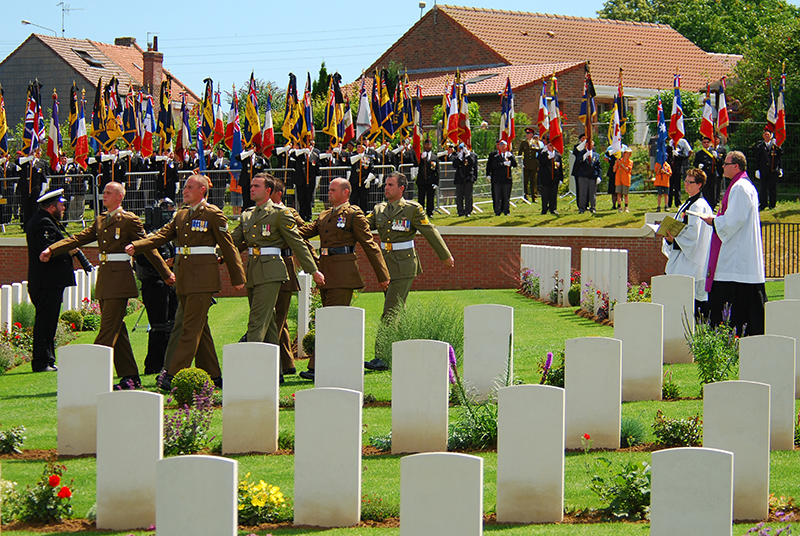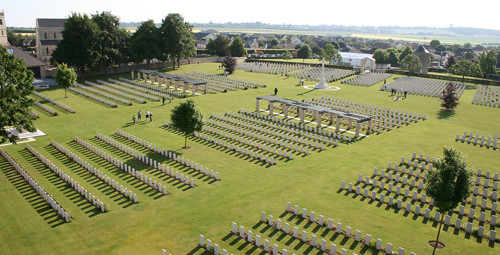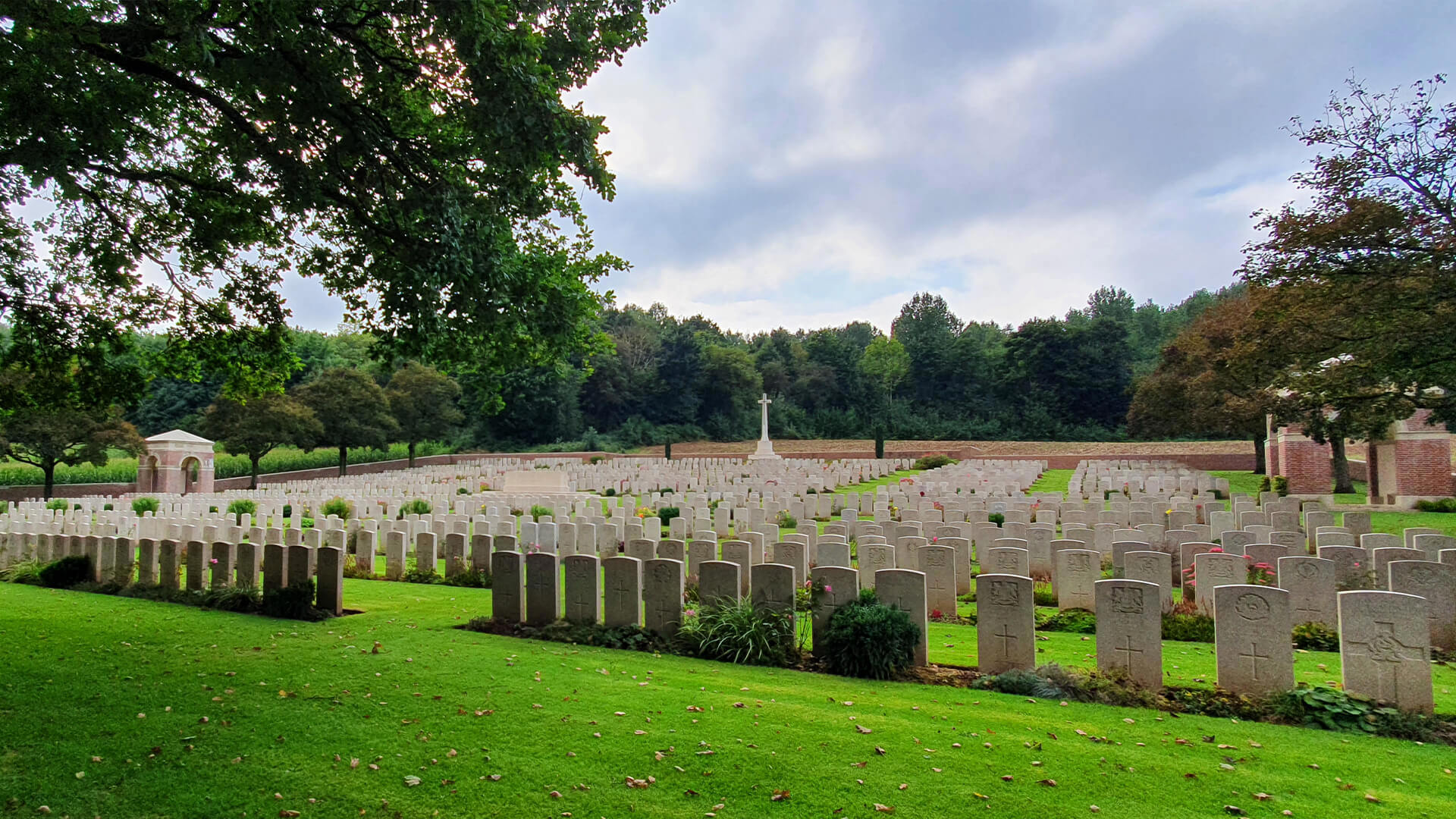27 September 2021
How to Find and Visit War Graves in France
Did you know that the Commonwealth War Graves Commission commemorates over 575,000 men and women of the Commonwealth forces who died during World War One and Two in France? In this handy guide Lucie Balin, from the CWGC, shows you how to find and then visit War Graves in France.
Where are the War Graves in France?
Most of the world war casualties in France are commemorated across northern France and in Normandy, making it the highest concentration of CWGC war graves anywhere in the world. In France, over 20 separate CWGC or national French war memorials to the missing were designed and built and about 3,000 cemeteries are cared for by the commission.
Finding War Graves in France
Discover how to find war graves in France using different features on the CWGC website.
Using CWGC’s website to find War Graves in France
So, let’s have a look at how to discover some of the final resting places of the world war dead cared for by the CWGC. When planning your trip to the Western Front, your first step should be to visit the CWGC website and prepare your itinerary. Using the dropdown ‘Visit Us’ menu, select ‘Find War Memorials and War Cemeteries’.
Then, select a country from the list, your locality of interest or, if you are already travelling around France, you can also use your current location. You will then get a list of all the war cemeteries and memorials near you.
Finding CWGC War Graves in France on the go
To make things even easier you could try downloading the CWGC’s mobile App which is available on the APP Store and Google Play Store. It’s a great travel companion when exploring the former battlefield sites of the Western Front and across France. You can quickly search for cemeteries by name, location, or use your phone’s location to find sites nearby.
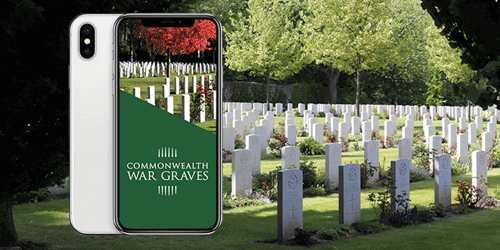
Searching for CWGC War Graves by Name
Interested in the Battles of the Somme, Cambrai or Arras? Another way of exploring our website to find a Commonwealth War Grave is to search by name. Albert, Pozières, Thiepval, Amiens, Vimy, Vis-en-Artois or Fromelles are not just names of towns and villages. They have also become associated with notions of tragedy and sacrifice, forever engraved in our memory.
To make your search even easier an exact match isn’t required, as you’ll be presented with a list of possible CWGC war cemeteries and memorials. In the Somme area alone, there are roughly 450 CWGC cemeteries and memorials to explore. A huge part of them reflects the magnitude and poignancy of the terrible losses endured during the battles fought in 1916.
From concentration cemeteries to front-line cemeteries, this is a place like no other to discover the extent and diversity of the work of the CWGC. And if you have a taste for adventure, allow yourself to go where the road leads you and get caught up in the beauty and history of the surroundings.
Using the war graves France map feature
If you like to see possible war graves to visit in France on a map, you can do so by hitting the ‘View as Map’ button. Then you can quickly see where everything is and find out more about CWGC’s war graves by selecting the cemetery.
Using the map feature also provides a good practical overview of the cemeteries in the location you plan to visit. In and around Beaumont-Hamel for instance, there are only a few hundred meters from one cemetery to the other. Redan Ridge Cemeteries N°1, 2 and 3 lie to the North of the village and were named after The Redan, a group of British front-line trenches from 1916.
Researching the War Dead before you visit
Before you make the journey out to France you might want to do a little bit of research about a casualty buried at a particular CWGC cemetery. You can do this from the cemetery page. First, go to records and find war dead and then you’ll be able to find out more about the casualties commemorated on site. The layout of the cemetery is also available to download and will help you locate any war graves you’d like to visit at the site.
Visiting War Graves in France
Trips to war graves in France can involve rich historical learnings and insight on those who lost their lives in WW1 and WW2. Find location information, visiting information and discover the history behind some of the key CWGC sites in France.
World War One War Graves to Visit in France
Over 530,000 Commonwealth servicemen and women died in France during World War One. With the first Battle of the Marne (1914), the Battle of the Somme (1916), The Spring Offensive and the Hundred Days Offensive (1918, among others, France was the scene of some of the bloodiest battles of the war.
Among the 1,200 cemeteries designed by the CWGC to commemorate them, is Etaples Military Cemetery. With 10,771 Commonwealth War Graves from World War One and 120 World War Two graves, in Pas-de-Calais, it is the largest cemetery maintained by the CWGC in France and the second largest in the world after Tyne Cot Cemetery in Belgium.
Located near Boulogne, on the north-west coast, Etaples was home to the largest British military base and army hospital complex. It’s 20,000 beds received up to 40,000 wounded and diseased each month. Almost 2,500 women served there, and 20 of them, including nurses, army auxiliaries and civilian volunteers of the YMCA and Scottish Church Huts organisations, are commemorated there.
One of the must-see sites when you visit the Western Front is Thiepval Memorial. It is the largest CWGC Memorial to the Missing in the world. Designed by Sir Edwin Lutyens and unveiled in 1932, it bears the names of over 72,000 officers and men of the United Kingdom and South African forces who died on the Somme during World War One and have no known grave.
But most of all, it stands as one of the most dramatic symbols of the bloodiest battle the Commonwealth forces ever faced: The Battle of the Somme of 1916.
Within the grounds of the memorial lies Thiepval Anglo-French Cemetery, where British and French servicemen lie side by side, representing the joint sacrifice of both nations during the First World War.
You may also be interested in: The history of German war graves in the UK
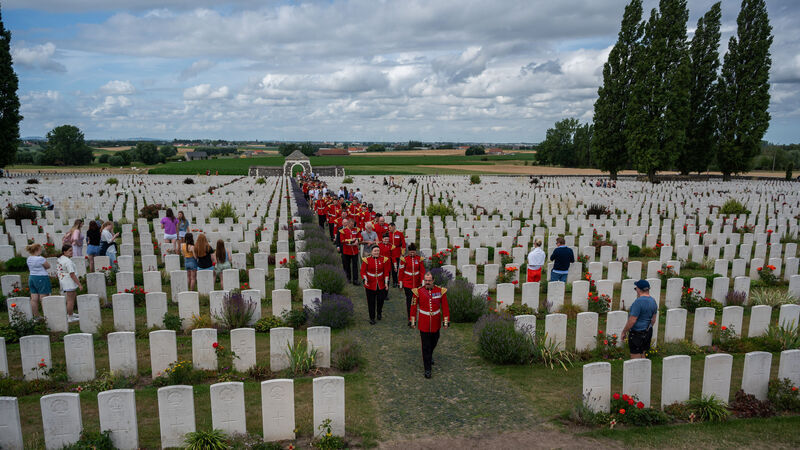
Want more stories like this delivered directly to your inbox? Sign up for our newsletter for regular updates on the work of Commonwealth War Graves, blogs, event news, and more.
Sign UpWorld War 2 War Graves in France
More than 22,000 Commonwealth servicemen and women died in Normandy during World War Two. Most were killed during Operation Overlord, and the liberation of Normandy, which began on D-Day, 6 June 1944. They lie at rest in cemeteries and churchyards across the Normandy region.
Among the 18 cemeteries designed and built by CWGC across Normandy, is Jerusalem War Cemetery which, with 49 graves, is one of the smallest. Its name comes from a tiny hamlet, named Jerusalem, located near the village of Chouain. The area was the scene of bitter fighting when a German armored column sought to retake Bayeux shortly after its liberation.
The largest Commonwealth cemetery of World War Two in France is Bayeux War Cemetery and contains burials brought in from the surrounding districts and nearby hospitals. There was little actual fighting in Bayeux, although it was the first French town of importance to be liberated. 4,144 Commonwealth servicemen are buried there, among which 338 are unidentified.
The Bayeux Memorial stands opposite the cemetery and bears the names of nearly 2,000 men of the Commonwealth land forces who died in this area and have no known grave.
Visiting Battlefields in France
Even after more than a hundred years since the end of World War One, the landscape of Northern France still carries visible reminders of the battles. Mine and shell holes, remains of trenches, ruins, and iron harvests: the scars of the Great War are still deeply inscribed in the countryside scenery.
It is very difficult, after paying your respect to a lost one, not to let yourself be absorbed in these impactful and enduring legacies of the war. This short battlefield guide contains a few ideas of WW1 battlefields you can visit on your journey around France.

The Lochnagar Crater (Somme)
The Lochnagar Crater, located a few kilometres at the North-East of Albert (Somme), highlights how mining was used as a military tactic during World War One. About a hundred meters wide and twenty-one meters deep, this impressive crater is the result of the detonation by British Forces of 27 tons of explosives packed into a long tunnel in the ground on 1st July 1916, marking thus the beginning of the Battle of the Somme.

The Beaumont-Hamel Newfoundland Memorial (Somme) and The Vimy Memorial (Pas-de-Calais)
The Beaumont-Hamel Newfoundland Memorial (near Albert) and The Vimy Memorial (near Arras) stand as lasting tributes to the 820 Newfoundlanders and 11,285 Canadians who were killed in France during World War One and have no known grave. In these poignant symbols of remembrance, you will have the opportunity to also explore remarkably well-preserved trench systems, which will give you a realistic idea of what the fighting must have been like.
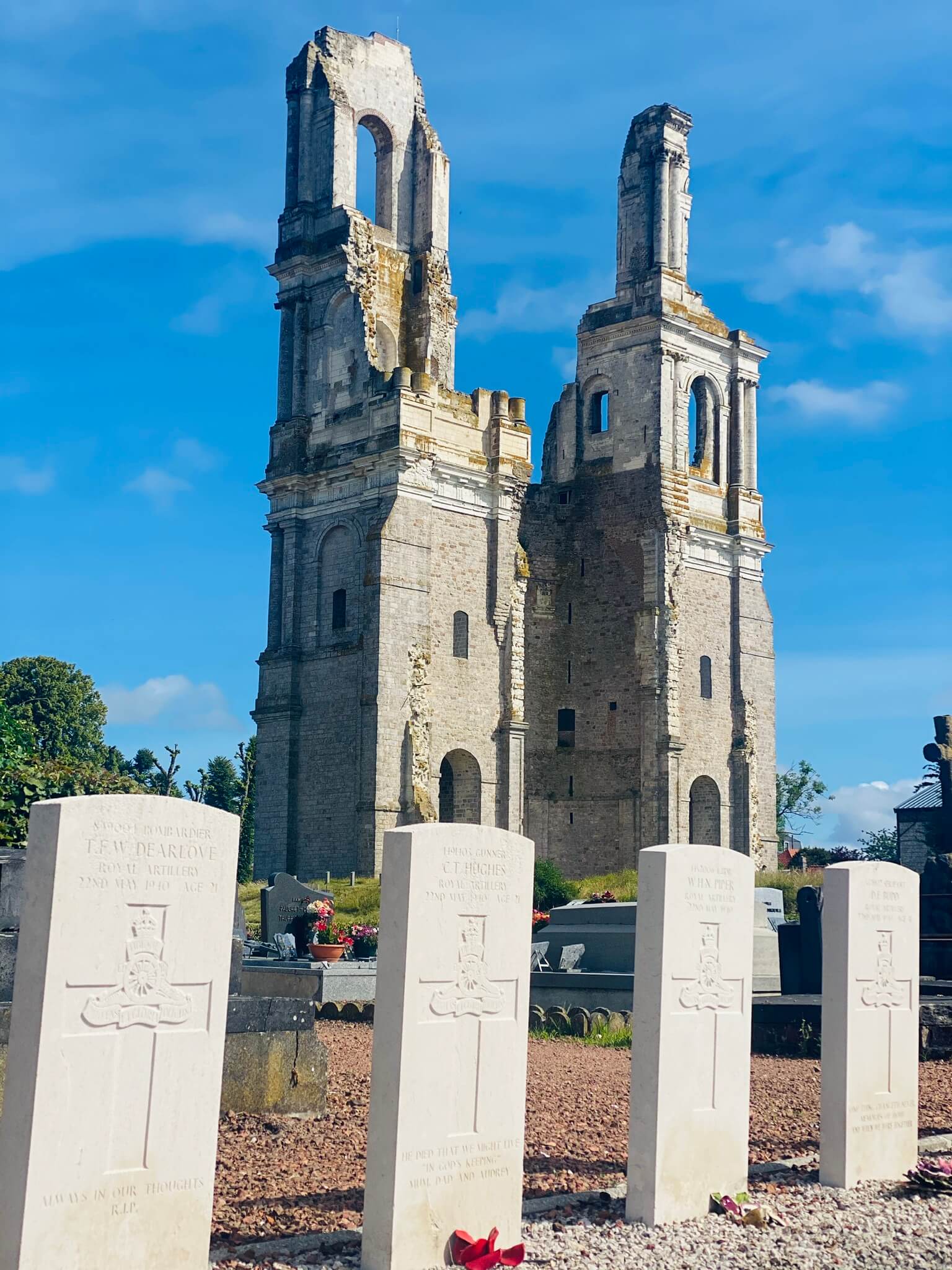
The ruined towers of Mont-Saint-Éloi Abbey
Located only ten minutes to the North-West of Arras, is the 18th century Mont-Saint-Eloi Abbey. From its vantage point at the top of a hill, the towers of the Abbey were useful and strategic observations posts for the occupying forces, firstly the French Army from 1914 to 1915, and the Commonwealth forces from 1916 to 1918. Already damaged during the French Revolution and pillaged in the 19th century, it was also severely pounded by German artillery during World War One, which caused the destruction of the upper level.

Visiting the Largest War Cemeteries in France
Explore some of the largest French war and military cemeteries we care for.
Etaples Military Cemetery
Removed from the Western Front, the area around Etaples was used mainly as an area for sick and wounded troops. A number of hospitals were positioned in the area, caring for around 22,000 patients.
As such, Etaples Military Cemetery is one of the largest CWGC cemeteries in France, with 10,771 Commonwealth burials from World War One, and 662 non-Commonwealth burials. The cemetery was also used for burials during the early stages of World War Two until the evacuation in 1940, with further burials made after the war. In total, there are 119 Second World War graves here.
St. Sever Cemetery Extension
During the First World War, the city of Rouen was used as a base of operations by the Allied soldiers, using it as a supply base depot, General Headquarters and a number of hospitals.
The casualties from these hospitals were buried in cemeteries around the city, with a large number buried in St. Sever Cemetery and its extension, which was begun in 1916. There are just over 3000 burials in the cemetery, with a further 8685 burials in the extension.
Cabaret-Rouge British Cemetery
Cabaret-Rouge British Cemetery is named after a small, red bricked, red tiled café which stood in the area and was destroyed during the opening years of the war. It lent its name to the sector of the front line, and a communications trench used by troops to get to the front line trenches.
The cemetery was begun in 1916 when soldiers fighting in the area began burying their comrades and was further expanded after the war as soldiers buried in the area were brought together at the cemetery.
This was an area of the front line that saw heavy fighting, and so the cemetery is one of the largest in France, containing more than 7,650 World War One burials, more than half of which remain unidentified.
Visit the CWGC Vistor centre in France to discover how CWGC’s War Graves are maintained
A journey to the Western Front is not complete without a visit to The CWGC Visitor Centre. If you’ve ever wondered how the CWGC commemorates the Commonwealth casualties from World War One & Two, The CWGC Experience offers an opportunity to discover more and see our staff in action.
Located in the heart of the battlefields of The First World War, The CWGC Visitor Centre is an easy drive away from some of the most iconic locations along the Old Front Line.
From the story of how we still recover and rebury the dead today, to the skilled artisan craftsmen at work maintaining the world's most impressive and recognisable war monuments and memorials. Free audio-guides and guided tours will tell you everything you need to know about our remarkable organisation and its role in France and around the world.
